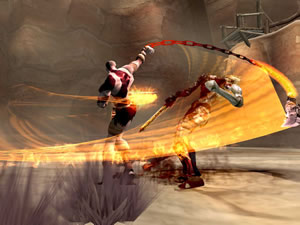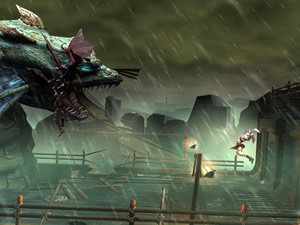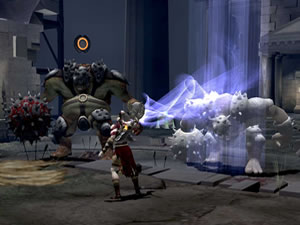God is dead meat.
As I entered the cathedral, my enemies arose from swirling mist as black as pitch, like a demonic infection Mother Gaea herself regurgitated onto the mortal realm. They believe – as did the hydra, the minotaur and so much fodder before them – that they can stay my hand from slaying a god. Fools.
From my blades I shook the viscous chunks of cyclops flesh onto the hall floor. Before they could react, I seized the nearest wraith, pinning its bony frame to the floor. With my foot firmly planted on its shoulder, I gleefully wrenched its bladed arm from the socket, which I then used to relieve the vile beast of its head. Another I tore in half, again with my bare hands. But while my enemies are legion, my time is fleeting. To hasten the slaughter I brandish my Blades of Chaos, and in a wash of blood and flame, the carnage is rejoined. My hunt for Ares, God of War, continues.
And so does the review.
Like a lightning bolt hurled from Olympus, Sony’s God of War has jolted PS2 action fans to life. The game’s fighting engine may not be as complex as some, but the incredibly satisfying gameplay, cinematic presentation and smart mechanics more than make up for it. With massive amounts of glorious violence wrapped up in a zesty Greek pita, this is the most adrenaline-charged PS2 beat ’em up since the first Devil May Cry.
You are Kratos, a fallen Spartan commander who sells his soul to the Greek god Ares in exchange for the death of his immediate enemy and, of course, demigod powers. In his newly tattooed, vitamin-D deficient form, Kratos commits unspeakable acts of violence and destruction. Visions and nightmares of his hideous deeds come to haunt his every hour. Infuriated with the thought of possibly going insane, Kratos vows to take down Ares himself. Luckily, Zeus, Athena and others in the pantheon are none too happy with Ares, as he is currently stomping through Athens with a seething army of monsters. With the other gods at his back, Kratos sets off to do what few mortals would dare ” to kill a god. Nietzsche would be proud.
Your quest takes you through various locales in mythical Greece by way of some truly impressive level design. You’ll scour the streets and sewers of Athens, investigate great shimmering halls within towering structures, brave blinding desert storms, survive the dangers of a ship at sea and much, much more. One of the most notable is scaling the titan Chronos to reach the massive city of Pandora, which Chronos is cursed to carry on his back. It’s awesome. Fans of the greek myths will be in heaven.
But don’t get caught sightseeing, because Ares isn’t called the god of war for nothing. Thankfully, the other gods have blessed you with your devastating Blades of Chaos, which have been cleverly attached to your forearms with long chains. Our tortured hero wields these like flaming, bladed whips, slicing and dicing enemies with ease. Ginsu beware.
This is where the bulk of the gameplay lies. Via his deadly blades, Kratos is a master warrior with a large repertoire of combos, dismembering grabs and throws. Use these to cut a swathe through undead legionnaires, annoying harpies, gorgons, minotaurs, screaming banshees and imposing cyclopes. Your fallen foes will yield one of three types of colored orbs: red currency, blue magic and green health. Kratos uses the red orbs to buy upgrades to either his magic or melee, including increased offensive power and additional attacks and/or combos.
 While Devil May Cry Dante’s kung-fu may be a bit more intricate, Perseus himself could learn a thing or two from Kratos’ super cool combos and parries. Kratos can more smoothly transition from bladed to magic attacks and back again, resulting in some truly wicked thrashings. The action is fast and intuitive as moves flow into one another effortlessly, leading to a fun, dynamic experience. Expect to see 30+ hit combos as your powers and number of attacks increase.
While Devil May Cry Dante’s kung-fu may be a bit more intricate, Perseus himself could learn a thing or two from Kratos’ super cool combos and parries. Kratos can more smoothly transition from bladed to magic attacks and back again, resulting in some truly wicked thrashings. The action is fast and intuitive as moves flow into one another effortlessly, leading to a fun, dynamic experience. Expect to see 30+ hit combos as your powers and number of attacks increase.
Sometimes, though, you won’t need to go combo crazy due to contextual fatalities specific to each enemy. Dispatching an enemy in this way is by no means mandatory, but the unfortunate baddie will release more orbs. It’s fairly basic in its implementation: When you see the Circle button symbol appear above an enemy, you get close and press Circle to start a series of buttons and/or analog movements. Nail it and the result is sheer bedlam, zoomed in and ultra cinematic. Decapitations, dismemberment and eviscerations, oh my!
Usually, clearing an area of all opposition will allow passage onward, but sometimes you’ll need to find items or keys or solve simple puzzles to continue. Don’t fret – items are typically easy to find and the puzzles make much more sense than in most games. These bits mostly exist to break up the heavy action sequences and are well-implemented.
Indeed, adventuring is another area in which God of War excels. When you’re not tearing the wings off harpies or poking out cyclops eye, you will swing on ropes, scale walls and vines and carefully balance on narrow beams and ledges. The animation for the latter is fantastic. Kratos sways and tries to balance himself while navigating beams; you’ll find yourself holding your breath and he teeters back and forth on a precipitous ledge. Sweet.
Such immersive moments are common thanks to the incredible cinematic flair of the entire game. Your journey to find Ares might not be the Golden Fleece of graphic quality – texture quality is merely decent, if not notable – but the level design is very impressive and the game’s particle effects are simply stunning. The combat animations are amazing, spurring you to whip out your myriad attacks over and over again. Other visual ambrosia includes the cinematic camera angles, which pan to handier vantage points during combo sequences. Couple this with the occasional Max Payne slowdown effect and you’ve got a movie-quality brawler on your hands.
 But for all its sweeping beauty, God of War is not without its foibles. Most obvious is the lack of multiplayer, although that’s not a huge deal since this is such a story-driven game. The number of enemy types, though, is a bit sparse. The killing is fun, but could use more variety.
But for all its sweeping beauty, God of War is not without its foibles. Most obvious is the lack of multiplayer, although that’s not a huge deal since this is such a story-driven game. The number of enemy types, though, is a bit sparse. The killing is fun, but could use more variety.
Then there’s that cinematic camera, which at times seems birthed from the pits of Hades. There is no ‘look’ button, so while the camera swings to and fro for the best view, you can’t stop it to look around and see where you’ve been and where you need to go. The camera will sometimes pan around you, at which point you’ll suddenly find yourself moving Kratos in the wrong direction. Don’t expect much help from the artsy-fartsy maps included in the manual: They look nice, but are useless.
Taking another cue from Devil May Cry, God of War makes it easy on those who die often’too easy, in fact. If you die enough times in the same place, the game automatically bumps the difficulty down to Easy despite giving you the option, “No, I don’t want to switch to Easy.” There is no way to switch the game back to Normal or Hard once you’ve gotten out of the particular jam, so remember to take advantage of all four save slots.
And while you’re at it, be sure to take advantage of your credit card by picking up a copy of this glorious action doozie immediately. We’re hard to impress when it comes to action gaming, but God of War really gets it right. With style and verve, this one is worthy of its classic Greek iconography as well as your hard-earned denari.
-
Enormous fun
-
Tons of combos and magic
-
Incredibly cinematic
-
Good story
-
Plenty of mature content
-
No multiplayer
-
Could use more enemy variety
-
Whereí¢â‚¬â„¢s the í¢â‚¬Ëœlookí¢â‚¬â„¢ button?







